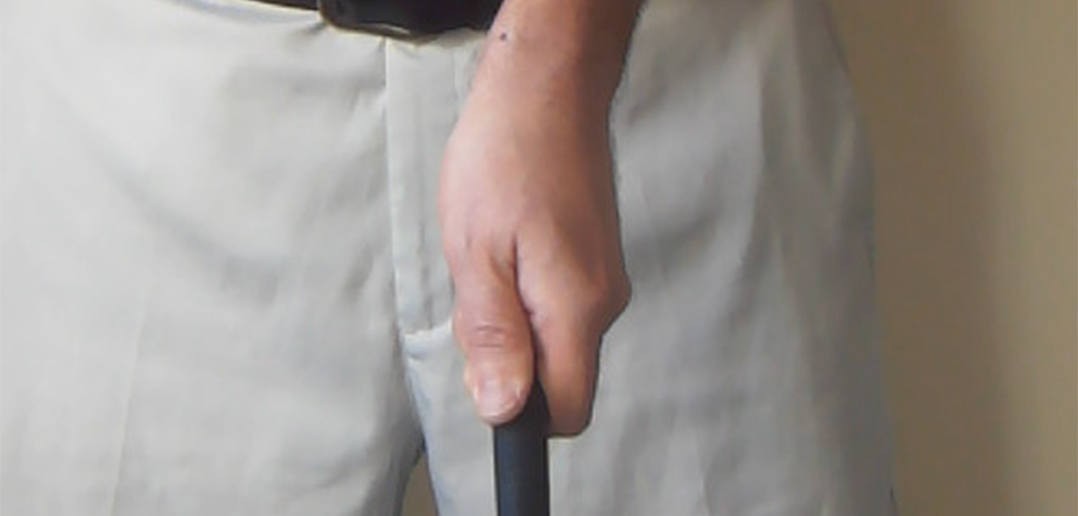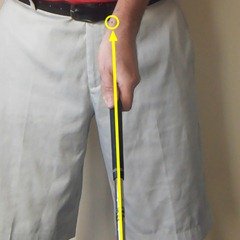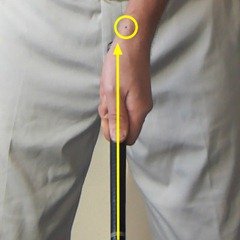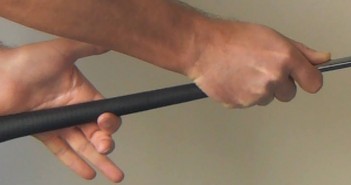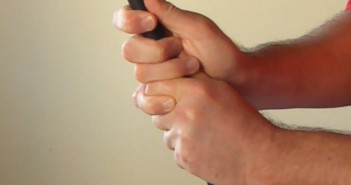This is the forth in a series of six articles describing the perfect golf grip, starting with Golf Swing 104a – Setup: The Perfect Golf Grip.
Once again, apologies to the lefties, for simplicity these instructions are given for a right-handed golfer.
The strength of your grip, strong or weak, is determined primarily by the position of your left hand — your control hand.
The grip recommended here in the Swing like a Champion system would be considered by purists to be a slightly strong grip. It will lead to a slightly steeper club plane than would a neutral grip, and a slightly closed club face at the top of your backswing — with a flat left wrist at the top, the club face will be angled slightly more towards the sky than will your left arm.
This slightly strong grip, however, is anatomically ideal, and it will give you the best control over the club face through impact.
With a slightly stronger grip, it is easier to square the club face at impact for most golfers. You will have less reliance on timing and manipulation as you release the club through impact. A strictly neutral grip can cause amateurs to try to flip the club through impact in an attempt to “slam the club face shut” and avoid a slice or blocked shot.
This grip will also gives you more control over the club, and it will enable you to generate more club head lag in your golf swing, because placing the club handle under the muscle bulge on the heel of your left hand (the hypothenar eminence) provides leverage on the club with your left wrist, without any special muscular effort, so your wrist is still soft. This enables you to maintain the lag late in the downswing while bowing your wrist to close the club face correctly coming into impact.
The grip we describe is not so strong that it will impact adversely on your feel, your shot-making finesse. You will still be able to work the ball, to feel the rotation of the club face as you draw the ball, or hold it off for a fade, etc.
Note that we don’t reference your “Vs” or your knuckles very much, which are normally used by teachers to describe grip strength. We prefer, instead, to talk about the position of the golf club in your hand and use the bony ridge on top of your wrist to precisely position your grip. We don’t want you to have a “V”, as such, your thumb and index finger should be touching. The notch between your thumb and index finger isn’t straight, but if you follow the instructions above then it will be, broadly, pointing up to somewhere just outside your right ear, but never outside your right shoulder.
When you look down at your left hand grip you will see 2 to 2.5 knuckles. This happens automatically by placing your hand as described above. It can be useful to confirm this in a mirror or on video when you are checking your grip — you should see 2 knuckles from face on.
If you are an advanced golfer who really wants a grip that is stronger or weaker than we recommend, do so by gripping the golf club as described, but moving the bony ridge on top of your wrist slightly to the right or left of centre, respectively — see Figures 1 to 3.
Many high-handicap golfers have a left hand grip that is too weak. This means that they don’t get the control and stability that is provided by the hypothenar eminence, the club often moves in the palm during the golf swing, and they can’t create or maintain club head lag.
Many amateurs have a grip that is far too strong, especially with their right hand. High-handicap golfers often have the destructive combination of a too-weak left hand and a too-strong right hand.
They may have strengthened their right hand in an attempt to get the right thumb behind the club shaft. The thumb is very powerful, and so they feel like they have more control.
Or they may have been told to strengthen their grip in order to fix their slice.
Both of these are horrible. They completely misunderstand how to use their hands in the golf swing, and while a “quick fix” might provide some small help, the result is that they will never have a good golf swing until they fix their “wrong thinking” and adopt a proper grip.
You should never adopt an imperfect grip in a “quick-fix” attempt to compensate for a swing fault.
If you have any questions or comments about this or other articles on Golf Loopy, please send us an email.
Next up: How to determine the proper grip pressure, in Golf Swing 104e – Setup: The Perfect Golf Grip – Grip Pressure.

